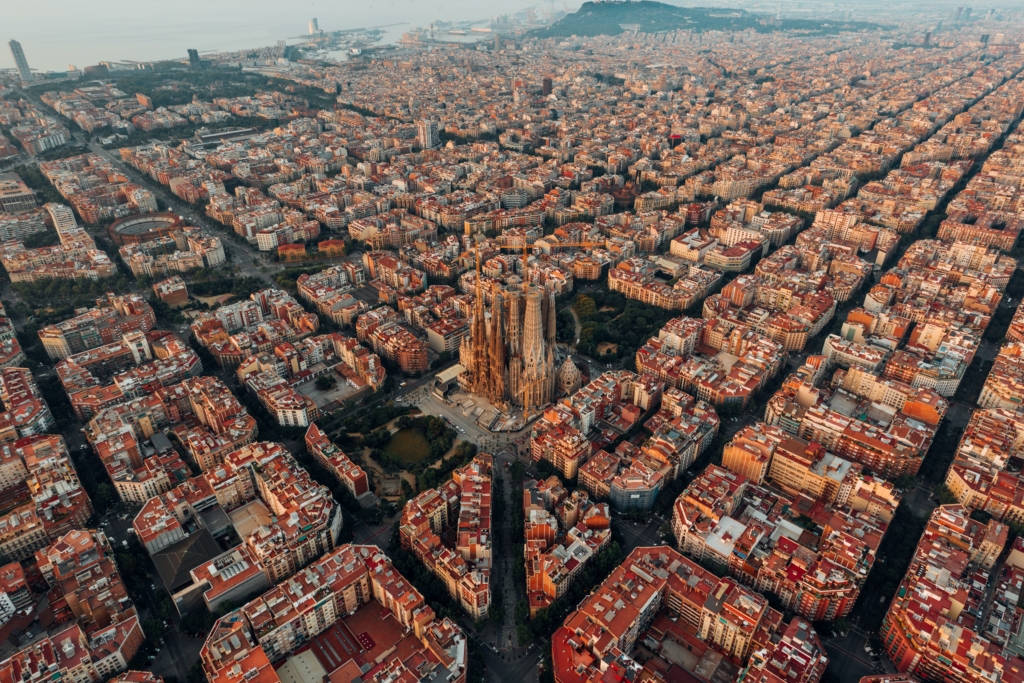The world could be your oyster, but it depends on your passport
October 10th, 2024
4 min
This article is brought to you by Datawrapper, a data visualization tool for creating charts, maps, and tables. Learn more.

Hey, this is Eddie! Here at Datawrapper, I work answering all your questions to support@datawrapper.de, posting on social media, and giving webinars. Since I started at the company over a year ago, I’ve been working remotely — and for the last three months, I’ve been doing it from the beautiful city of Barcelona. Today, I’m going to tell you about a project that’s been launched to make Barcelona greener and reclaim it from cars. Contrary to what you might expect, this is not a modern idea, but something envisioned for this coastal city a long time ago.
When thinking of Barcelona, the first thing that comes to mind is its famous grid system. If you walk through the city or have the opportunity to see it from above, you will soon realize that a large part of it is composed of a perfect grid-like pattern of streets. The story behind this revolutionary design dates back to the 19th century, when the city was suffocating confined by its medieval walls. Back then, Barcelona had a population density of 856 inhabitants per hectare, twice that of Paris at the time.
With mortality rates rising and life expectancy dropping to 36 years for the rich and 23 years for the working classes, an unknown Catalan engineer, Ildefons Cerdà, decided to step in. He proposed to unite the old city with the smaller towns that surrounded it. His project took the name of Eixample (“Extension” in English) and was constructed in the 19th and early 20th centuries. He also invented “urbanization,” a word and discipline that he codified in his “General Theory of Urbanization.”

Cerdà studied the city and how residents interacted with it and came up with a grid pattern of equally sized blocks. Each block was made into an octagon, with cut off corners, allowing drivers to see more easily what was happening to the left and right. Even though Cerdà came up with his design before cars existed, he made sure the city’s layout was optimized for trams and other vehicles to reduce crashes and traffic jams.
A hundred years on, his work is still one of the most distinctive elements of the city. However, most of the intersections between streets that he envisioned as green, open spaces are now for commercial use, and Barcelona is, once again, one of Europe’s most densely populated cities. On top of that, according to a study from 2019, pollution in Barcelona is the cause of 7% of natural deaths, killing about a thousand people per year. Cerdà’s creation, the central district of Eixample, is also the most exposed to contamination.
With cars dominating the city and Barcelona getting increasingly polluted, a new model emerged to make the city greener and friendlier to pedestrians. In 2016, the City Council announced the "Superilles" project ("Superblocks" in English), groups of streets in which pedestrians have priority over cars.
Superilles consist of nine square city blocks in which the inside has been closed off to through traffic, the speed limit is set to 10 km/h, and curbside parking has been replaced by underground parking. The space left by cars is occupied by markets, common areas, and places where children can play, and people can talk and mingle. This project has been tested in the neighborhoods of Poblenou, Horta, and Sant Antoni.
In a nutshell, Superilles operate as "mini villages," where pedestrians and bikes can enjoy the space. Certain vehicles are allowed inside, but they can't go through. The interior is shaded by trees, and the squares can be used for games, sports, and cultural activities. These squares usually include tables, benches, plants, play areas, and cycle lanes.
Following the success of the first Superilles, the city has recently launched a 10-year plan to reclaim the streets back from cars. The goal is to give space to pedestrians, reduce pollution, and make Barcelona greener. For example, in the district of Eixample, they expect to build 21 public squares and turn one in three streets into green zones.
The Superilles are a continuation of what Cerdà envisioned for Barcelona and an internationally recognized symbol of innovative urban planning. Although criticized by some, they've proved to be successful at building a healthier city. In Sant Antoni, for example, the levels of nitrogen dioxide, which is linked with a higher rate of asthma attacks, have decreased by 33%, according to the City Council.
Once completed, Superilles aim to achieve a healthier, greener, fairer, and safer Barcelona that is better for social relations and the local economy.
Thanks so much for reading! If you've made it this far, you should send me an email at edurne@datawrapper.de to let me know about any projects going on in your city to democratize its public space. And if you have ideas for future Weekly Charts, don't hesitate to send them my way. Next week, it’s our office manager Daniela’s turn to write her Weekly Chart — she writes fascinating ones (like this one about milk alternatives, and this one about female representation in parliaments), so stay tuned!
I hope you found Superilles as interesting as I did! Here are some resources if you want to learn more about them:
Comments